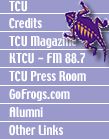|
Tuesday,
October 16, 2001
TCU
campus can do more for environment
By Antoinette
Vega
Skiff Staff
The phrase
“a little goes a long way” doesn’t apply when
it comes to TCU’s efforts to be environmentally conscious.
On the surface, the green grass and the neatly-kept grounds
give TCU the appearance of being an environmentally conscious
school, but is it? Students may think that they are doing
all they can for the environment on campus, but the fact is
they could be doing much more.
Waste
not
Everyday
activities of TCU students create waste that can be recycled,
reduced and reused. They drink beverages out of aluminum cans
and glass and also use paper regularly in classes and work.
Cheryl
West, manager of residential housekeeping, said each building
makes an effort to participate in a recycling program placing
recyclable materials in recycling bins. The residence halls
participate in an unofficial recycling program, she said.
“The
students and housekeeping work together to maintain a recycling
system,” West said. “The students recycle the items
and the housekeepers empty them.”
Kendall
Hartung, president of the TCU chapter of Alpha Phi Omega,
said the community service group used to participate in a
recycling program but had to stop because they could no longer
access golf carts to pick up recycling bags in each dorm.
“It
was frustrating to see the program end,” Hartung said.
“It was the members’ favorite service project and
the pick-up was more organized and consistent when it was
run by students.”
A bin
for recycling is easily accessible in most buildings for students,
faculty and staff, but personal bins can be created for the
purpose of being recycle conscious.
Leo Newland,
director of environmental sciences, uses a small brown box
next to his desk because he said he could not find the public
recycling bin in Sid W. Richardson Building.
While
this recycling effort is a start, there are currently no recycling
bins for glass or Styrofoam products, which are used regularly
on campus.
Robert
Sulak, assistant director of landscaping and grounds, said
there have been increased efforts to minimize litter by placing
trash cans in areas that have large amounts of student traffic.
Trash cans are visible beside every elevator and outside every
building on campus and are also in various places such as
next to bus stops, he said.
Littering
does not seem to be a growing problem. Housekeeper Ray Brown
said he has noticed that campus littering has decreased significantly
since his arrival to TCU five years ago.
“There
is less trash on the grounds and in the buildings,” Brown
said. “Students should realize that it is their responsibility
to help maintain the cleanliness of the campus because housekeeping
has many other things to do.”
Just
say, “for here”
Workers
in The Main wear purple and white buttons that read, “Ask
me for a plate.”
They are
worn to remind students to ask for a plate if they are dining
in The Main instead of creating waste by eating out of to-go
Styrofoam containers.
Some students
say they don’t understand the purpose of the buttons,
but some students just ignore them altogether.
Aaron
Marez, a sophomore political science major, said he eats out
of the Styrofoam plates even when he dines in The Main because
he prefers them to plates.
“I
like them better because they are divided into sections and
hold more food than the plates,” Marez said. However,
some students say that they were unaware of this conservation
measure because the workers don’t ask.
“I
just grabbed what the food worker handed me,” said Jennifer
Melrose, a freshman mathematics major. “I wasn’t
asked if I needed a to-go plate — I just received one.”
Stephanie
Dickerson, supervisor of dining services, said workers are
supposed to ask students if they would be needing a plate
or a to-go container.
“The
buttons were created this semester and many students do ask
for a plate on their own,” Dickerson said.
Rebecca
Mann, purchasing supervisor, said 1,600 to-go containers are
used daily and 1,500 soup containers, 1,000 salad bowls and
2,500 cups are used in both The Main and Edens.
Newland
said Styrofoam is not biodegradable and is difficult to recycle,
but the alternatives of paper or plastic have just as many
problems.
“Paper
and plastic are recyclable, but the chemicals and oils used
in the recycling process release toxins unhealthy for the
environment,” said Newland. “Porcelain is the best
because it is washable and can be reused time after time.
But the university would have to put up the (money) for it,
which is unlikely to happen.”
The
answer is change
From
changing our daily activities and product usage to taking
the initiative to create programs enforcing recycling, students
need to work together to achieve a more environmentally friendly
campus. Starting organizations that make students more environmentally
aware, such as the Greening of Campuses, a program aimed at
setting recommendations for an environmentally sustainable
future, is a way to get started.
“TCU
should be more proactive to find better ways to be environmentally
conscious and the Greening of Campuses would be beneficial
to the campus and the environment,” said Newland.
Students
and faculty members need to be aware of the environment and
should work hard to contribute to its improvement. It is an
individual decision one has to make to benefit society as
a whole.
“The
environment is constant,” Newland said. “It is the
students and the faculty that have to change.”
Antoinette Vega
a.c.vega@student.tcu.edu
|
